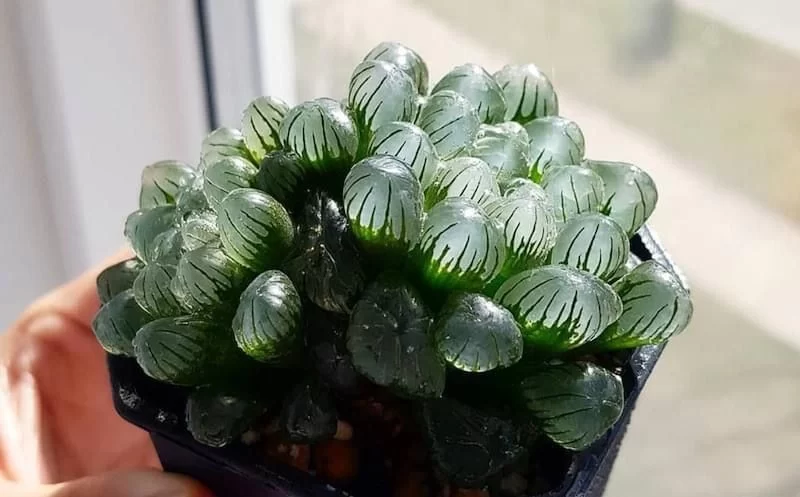Haworthia Ice Jade, also known as Haworthia Cooperi, is a popular cultivar of the Haworthia Cooperi species, which is a member of the succulent family native to South Africa. This cultivar is known for its unique, blue-gray leaves that have a frosted appearance, giving it the name “ice jade.”

The Haworthia plant species has been cultivated for centuries for their attractive leaves, which are often used in bonsai and succulent gardens. This cultivar is a favorite among succulent enthusiasts, due to its unique appearance and easy care. In this article, we will explore the characteristics, care, and ways to incorporate Haworthia Ice Jade into your garden.
Characteristics of ‘Haworthia-Ice Jade’
- The unique frosted appearance of the leaves is the most striking feature of Haworthia Ice Jade (Haworthia Cooperi), which sets it apart from other Haworthia cooperi. The leaves are thick and plump, and they grow on thick stems.
- The Haworthia Ice Jade is a slow-growing variety, which makes it a great option for small indoor gardens or for use in bonsai.
- Its leaves are fleshy and plump, typically colored blue-green, and rosette shape.
Care and Maintenance
- Lighting: Haworthia Ice Jade does well in bright, indirect light. It can tolerate some direct sunlight, but it’s best to keep it out of hot, afternoon sun to prevent sunburn.
- Watering: This plant should be allowed to dry out slightly between waterings. Overwatering can cause the leaves to turn yellow and fall off. A good rule of thumb is to wait until the top inch of soil is dry before watering.
- Soil: A well-draining cactus or succulent soil mix is ideal for Haworthia Ice Jade.
- Propagation: Haworthia Ice Jade can be propagated easily through leaf or stem cuttings. Allow the cuttings to callus over before planting.
Tips:
- Keep the soil slightly moist, but do not allow the plant to sit in water.
- It’s not tolerant to frost, keep it indoors during the winter months
- Avoid moving it around too much, as it may lose its leaves.
Incorporating ‘Haworthia Ice Jade’ into Your Garden
- Indoor settings: Haworthia Ice Jade (Haworthia cooperi) plant is a great option for small indoor gardens, and it can be used as a standalone plant or incorporated into a succulent garden.
- Outdoor settings: It can also be used in outdoor rock gardens, succulent gardens, or as a container plant on a shady patio.
- Companion plants: Haworthia Ice Jade pairs well with other succulents, such as Echeveria or Sedum.
- Uses: It’s an excellent choice for a small space or a windowsill. And it’s also a great option for Bonsai or terrariums.
In summary, Haworthia Ice Jade is a unique and easy-to-care-for cultivar of the Haworthia cooperi species with a frosty appearance. It’s a slow-growing plant that can be used in a variety of settings, including indoor and outdoor gardens, terrariums and bonsai. With proper care, it can provide years of enjoyment. If you’re looking to add a touch of frosty beauty.
Some common FAQs:
Q1: What are the ideal lighting conditions for Haworthia Ice Jade?
Haworthia Ice Jade does well in bright, indirect light. It can tolerate some direct sunlight, but it’s best to keep it out of hot, afternoon sun to prevent sunburn.
Q2: How often should I water my Haworthia Ice Jade?
This plant should be allowed to dry out slightly between waterings. Overwatering can cause the leaves to turn yellow and fall off. A good rule of thumb is to wait until the top inch of soil is dry before watering.
Q3: Can Haworthia Ice Jade be propagated through leaf cuttings?
Yes, Haworthia Ice Jade can be propagated easily through leaf or stem cuttings. Allow the cuttings to callus over before planting in well-draining soil.
Please note that, The above answer may slightly vary depending on the climate and specific environment you are growing the plant in, it is always best to consult with a local expert or botanical garden for more information on the specific care requirements for your Haworthia Ice Jade.
